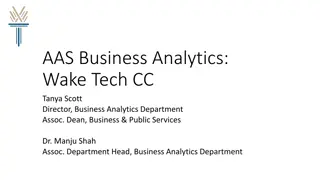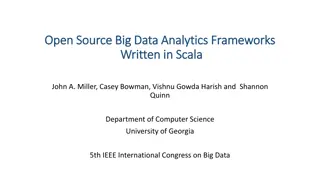Applied Data Analytics Curriculum Development for Sustainable Smart Industry in Thailand
This curriculum development session focuses on basic concepts of statistics, covering population vs. sample, census, descriptive vs. inferential statistics, and methods for summarizing data using tabular, graphical, and numerical techniques. The session includes examples and visual representations to enhance understanding.
Download Presentation

Please find below an Image/Link to download the presentation.
The content on the website is provided AS IS for your information and personal use only. It may not be sold, licensed, or shared on other websites without obtaining consent from the author. Download presentation by click this link. If you encounter any issues during the download, it is possible that the publisher has removed the file from their server.
E N D
Presentation Transcript
Applied Data Analytics Curriculum Development of Master s Degree Program in Industrial Engineering for Thailand Sustainable Smart Industry
Session 1: Basic Concepts Curriculum Development of Master s Degree Program in Industrial Engineering for Thailand Sustainable Smart Industry
Introduction What is Statistics? Science of gathering, analyzing, interpreting, and presenting data Population Versus Sample Population the whole: a collection of persons, objects, or items under study Sample a portion of the whole: a subset of the population Census process of gathering data from the entire population for a measurement of interest.
Descriptive Statistics Descriptive vs. Inferential Statistics Descriptive Statistics statistics gathered on a group to describe or reach conclusions about that same group only. Inferential Statistics statistics gathered on sample data to reach conclusions about the population from which the sample was taken.
Descriptive Statistics Descriptive Statistics Descriptive statistics are the tabular, graphical, and numerical methods used to summarize data. Example: The manager of Hudson Auto would like to have a better understanding of the cost of parts used in the engine tune-ups performed in the shop. She examines 50 customer invoices for tune- ups. The costs of parts, rounded to the nearest dollar, are listed below:
Descriptive Statistics 91 71 104 74 85 62 78 69 93 72 62 88 98 57 89 68 68 101 79 75 66 97 83 52 75 105 77 68 105 79 99 79 80 75 65 69 69 97 72 80 67 62 62 76 109 74 73 97 82 71
Descriptive Statistics Tabular Summary Parts Cost ($) Frequency Frequency 50-59 60-69 70-79 80-89 90-99 100-109 Total Percent 2 13 16 7 7 5 50 100 4 26 32 14 14 10
Descriptive Statistics Graphical Summary (Histogram)
Descriptive Statistics Numerical Descriptive Statistics The most common numerical descriptive statistic is the average (or mean). Others: mode, median, variance, standard deviation, etc.
Statistical Inferences Statistical Inference The process of using data obtained from a small group of elements (the sample) to make estimates and test hypotheses about the characteristics of a larger group of elements (the population). Parameter vs. Statistic Parameter descriptive measure of the population Usually represented by Greek letters Statistic descriptive measure of a sample Usually represented by Roman letters
Statistical Inferences Population Parameters: : denotes population mean (expected value) : denotes population variance. : denotes population standard deviation Sample Parameters: : denotes sample mean : denotes sample variance. : denotes sample standard deviation s 2 x 2s
Statistical Inferences Process of Inferential Statistics x Calculate to estimate x Sample (statistic) Population (parameter) Select a random sample
Data Measurement Scales/Levels of Data Measurement Nominal Lowest level of measurement Ordinal Interval Ratio Highest level of measurement The scale determines the amount of information contained in the data. The scale indicates the data summarization and statistical analyses that are most appropriate.
Data Measurement Nominal Level Data Data are labels or names used to identify an attribute of the element. A nonnumeric label or a numeric code may be used. Numbers are used to classify or categorize
Data Measurement Example: Students of a university are classified by the school using a nonnumeric label: Business, Humanities, Education, and so on. Alternatively, a numeric code could be used (e.g. 1 denotes Business, 2 denotes Humanities, 3 denotes Education, ). Employment Classification: 1 for Educator; 2 for Construction Worker; 3 for Manufacturing Worker
Data Measurement Ordinal Level Data The data have the properties of nominal data and the order or rank of the data is meaningful. A nonnumeric label or a numeric code may be used. Numbers are used to indicate rank or order Relative magnitude of numbers is meaningful Differences between numbers are not comparable
Data Measurement Examples: Students are classified as Freshman, Sophomore, Junior, or Senior. Alternatively, a numeric code could be used (e.g. 1 denotes Freshman, 2 denotes Sophomore, and so on). Position within an organization 1 for President 2 for Vice President 3 for Plant Manager 4 for Department Supervisor 5 for Employee Likert scale in questionnaire: Strongly Agree Strongly Disagree Agree Neutral Disagree
Data Measurement Interval Level Data The data have the properties of ordinal data and the interval between observations is expressed in terms of a fixed unit of measure. Interval data are always numeric. Distances between consecutive integers are equal Relative magnitude of numbers is meaningful Differences between numbers are comparable Location of origin, zero, is arbitrary and not mean the absence of the phenomenon Vertical intercept of unit of measure transform function is not zero Example: Fahrenheit Temperature (32+9/5*Centigrade)
Data Measurement Ratio Level Data The data have all the properties of interval data and the ratio of two values is meaningful. Variables such as distance, height, weight, and time use the ratio scale. This scale must contain a zero value that indicates that nothing exists for the variable at the zero point.
Data Measurement Highest level of measurement Relative magnitude of numbers is meaningful Differences between numbers are comparable Location of origin, zero, is absolute (natural) Examples: Height, Weight, and Volume Example: Monetary Variables: Profit and Loss, Revenues, Expenses
Data Measurement Data Level Meaningful Operations Statistical Method Nominal Classifying and Categorizing Nonparametric Ordinal All of the above plus Ranking Nonparametric Interval All of the above plus Addition, Subtraction, Multiplication Parametric (Nonparametric) Parametric (Nonparametric) Ratio All of the above and Division
Data Measurement Nonparametric statistics: A class of statistical techniques that make few assumptions about the population Used with nominal and ordinal level data Parametric statistics: A class of statistical techniques that contain assumptions about the population Used only with interval & ratio level data
Ungrouped vs. Grouped Data Ungrouped data have not been summarized in any way are also called raw data Grouped data have been organized into a frequency distribution
Ungrouped vs. Grouped Data Example: Ages of a sample of managers 42 26 32 34 57 30 58 37 50 30 53 40 30 47 49 50 40 32 31 40 52 28 23** 35 25 30 36 32 26 50 55 30 58 64 52 49 33 43 46 32 61 31 30 40 60 74* 37 29 43 54
Ungrouped vs. Grouped Data Frequency Distribution of Manager s Ages: Class Interval 20-under 30 30-under 40 40-under 50 50-under 60 60-under 70 70-under 80 Frequency 6 18 11 11 3 1
Ungrouped vs. Grouped Data Range and Class Data Range: Range = Largest Smallest Ex: Range = 74 23 = 51 Number of Classes and Class Width The number of classes should be between 5 and 20. Fewer than 5 classes cause excessive summarization. More than 20 classes leave too much detail.
Ungrouped vs. Grouped Data Class Width Divide the range by the number of classes for an approximate class width Round up to a convenient number Ex: Approximate Class Width = 51/6 = 8.5 Class Width = 10
Ungrouped vs. Grouped Data Relative Frequency Class Interval 20-under 30 30-under 40 40-under 50 50-under 60 60-under 70 70-under 80 Total Frequency 6 18 11 11 3 1 50 Relative Frequency .12 .36 .22 .22 .06 .02 1.00
Ungrouped vs. Grouped Data Cumulative Frequency Class Interval 20-under 30 30-under 40 40-under 50 50-under 60 60-under 70 70-under 80 Total Frequency 6 18 11 11 3 1 50 Cumulative Frequency 6 24 35 46 49 50
Ungrouped vs. Grouped Data Cumulative Relative Frequencies Class Interval 20-under 30 30-under 40 40-under 50 50-under 60 60-under 70 70-under 80 Total Frequency RF Cu. Frequency 6 .12 18 .36 11 .22 11 .22 3 .06 1 .02 50 1.00 CRF .12 .48 .70 .92 .98 1.00 6 24 35 46 49 50
Measures of Central Tendency Ungrouped Data Measures of central tendency yield information about particular places or locations in a group of numbers. Common Measures of Location Mode, Median, Mean, Percentiles, Quartiles
Measures of Central Tendency Ungrouped Data Mode The most frequently occurring value in a data set Applicable to all levels of data measurement (nominal, ordinal, interval, and ratio) Bimodal -- Data sets that have two modes Multimodal -- Data sets that contain more than two modes
Measures of Central Tendency Ungrouped Data Example: 35 41 44 45 37 41 44 46 37 43 44 46 39 43 44 46 40 43 44 46 40 43 45 48 Value 44 occurs 5 times The mode is 44 Mode is often used in determining sizes (garment industry): S, M, L, XL, XXL (modal sizes)
Measures of Central Tendency Ungrouped Data Median Middle value in an ordered array of numbers. Applicable for ordinal, interval, and ratio data Not applicable for nominal data Unaffected by extremely large and extremely small values Median is determined without using all information from the data set.
Measures of Central Tendency Ungrouped Data Computational Procedure Arrange the observations in an ordered array. If there is an odd number of terms, the median is the middle term of the ordered array. If there is an even number of terms, the median is the average of the middle two terms.
Measures of Central Tendency Ungrouped Data Example: Ordered Array: 3 4 5 7 8 9 11 14 15 16 16 17 19 19 20 21 22 - There are 17 terms in the ordered array. - Position of median = (n+1)/2 = (17+1)/2 = 9 - The median is the 9th term, 15. Ordered Array: 3 4 5 7 8 9 11 14 15 16 16 17 19 19 20 21 - There are 16 terms in the ordered array. - Position of median = (n+1)/2 = (16+1)/2 = 8.5 - The median is between the 8th and 9th terms: 14.5.
Measures of Central Tendency Ungrouped Data Arithmetic Mean Commonly called the mean : the average of a group of numbers Applicable only for interval and ratio data Affected by each value in the data set, including extreme values Computed by summing all values in the data set and dividing the sum by the number of values in the data set
Measures of Central Tendency Ungrouped Data Population Mean Sample Mean
Measures of Central Tendency Ungrouped Data Percentiles Measures of central tendency that divide a group of data into 100 parts. Applicable for ordinal, interval, and ratio data At least n% of the data lie below the nth percentile, and at most (100 - n)% of the data lie above the nth percentile Example 90th percentile indicates that at least 90% of the data lie below it, and at most 10% of the data lie above it The median is the 50th percentile.
Measures of Central Tendency Ungrouped Data Computational Procedure 1. Organize the data into an ascending ordered array. P = ( ) n i 2. 3. Calculate the percentile location: Determine the percentile s location and its value. 100 If i is a whole number, the percentile is the average of the values at the i and (i+1) positions. If i is not a whole number, the percentile is at the ([i]+1) position in the ordered array.
Measures of Central Tendency Ungrouped Data Example Raw Data: 14, 12, 19, 23, 5, 13, 28, 17 Ordered Array: 5, 12, 13, 14, 17, 19, 23, 28 30 100 ( ) i = = 8 2.4 Location of 30th percentile: The location index, i, is not a whole number; [i ]+1 = 2+1=3 The 30th percentile is at the 3rd location of the array: the 30th percentile is 13.
Measures of Central Tendency Ungrouped Data Quartiles Measures of central tendency that divide a group of data into four subgroups Q1 is equal to the 25th percentile Q2 is located at50th percentile and equals the median Q3 is equal to the 75th percentile
Measures of Central Tendency Ungrouped Data Example Ordered array: 106, 109, 114, 116, 121, 122, 125, 129 + 25 100 50 100 75 100 109 114 2 116 121 2 122 125 2 ( ) 8 = = = = : 2 111.5 Q i Q 1 1 + ( ) 8 = = = = : 4 118.5 Q i Q 2 2 + ( ) 8 = = = = : 6 123.5 Q i Q 3 3
Measures of Central Tendency Grouped Data Mean of Grouped Data Weighted average of class midpoints Class frequencies are the weights or N f = N N if M N f M = = = i i i i = 1 1 i i 1 i
Measures of Central Tendency Grouped Data Example Class Interval 20-under 30 30-under 40 40-under 50 50-under 60 60-under 70 70-under 80 Total Frequency 6 18 11 11 3 1 50 Class Midpoint 25 35 45 55 65 75 2150 43.0 50 fM 150 630 495 605 195 75 2150 N if M N = = = = i i 1
Measures of Central Tendency Grouped Data Median of Grouped Data N cf 2 p ( ) + Median = L W f where: med L cfp fmed W N : the lower limit of the median class : cumulative frequency of class preceding the median class : frequency of the median class : width of the median class : total of frequency
Measures of Central Tendency Grouped Data Example Note that N/2 = 25, therefore the median is the average of the 25th and 26th values. So, the median class: 40-under 50. Class Interval Frequency Cu. Frequency 20-under 30 6 30-under 40 18 40-under 50 11 50-under 60 11 60-under 70 3 70-under 80 1 N = 50 6 24 35 46 49 50 50 2 24 ( ) = + = Median 40 10 40.9 11
Measures of Central Tendency Grouped Data Mode of Grouped Data Midpoint of the modal class Modal class has the greatest frequency Example (see the former slide) The modal class is 30-under 40. So, Mode = 35.
Measures of Variability Ungrouped Data Measures of variability describe the spread or the dispersion of a set of data. Common Measures of Variability Range Interquartile Range Mean Absolute Deviation Variance Standard Deviation Z scores Coefficient of Variation
Measures of Variability Ungrouped Data Range The difference between the largest and the smallest values in a set of data Simple to compute Ignores all data points except the two extremes

























